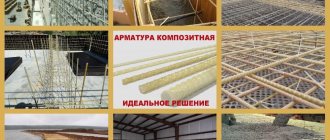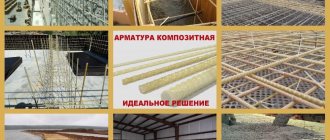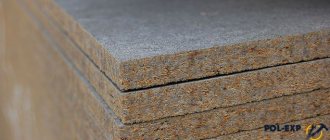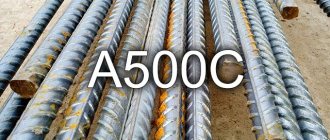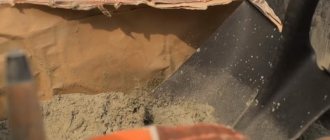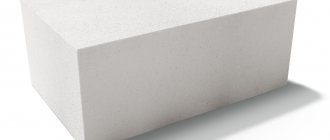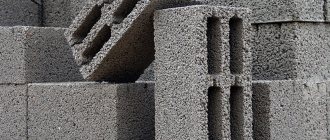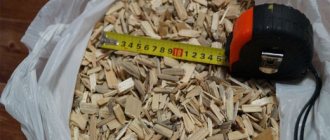Frame made of plastic rods for pouring the foundation.
Plastic reinforcement for the foundation is a modern material, which is a type of composite variety. It is used in construction together with its steel counterpart to strengthen the base. There are both positive and negative reviews about it. The main advantages of this material: light weight and a number of strength parameters. Plastic reinforcement replaces steel rods not only in the construction of foundations, but also in the construction of roads, bridges, walls, ceilings, and fences.
The nuances of knitting plastic reinforcement
When preparing the frame for different types of foundations, various techniques for knitting composite reinforcement are also used. Knitting methods take into account the features of monolithic structures. Let's look at the most popular options for knitting fiberglass rods.
For strip foundation
Tying fiberglass reinforcement for a strip foundation is complicated by the presence of side connections, many intersections and the need to prepare corners.
At the points of contact between the foundation lines, the frames are connected using U-shaped fragments. In this way, the perpendicular mesh is connected to the external reinforcement.
To form corners, fiberglass rods are bent at right angles, but this is not easy to do on a construction site, so more often they simply order ready-made L-shaped products, which are tied with wire to the main frame. In this case, the overlap must be at least 300 mm, and the number of ties must be at least two.
If you have to bend the rods in place, you should do this very carefully. The use of fire or any other thermal method of imparting greater plasticity to the reinforcement is unacceptable
In this case, the reinforcement will lose its original characteristics and will not be able to cope with the design load.
The finished reinforcing mesh in the strip foundation frame is connected by straight sections. The intersections are joined inside the formwork at the installation point.
When knitting a frame for a strip foundation, you should adhere to the following rules:
- You can knit the frame both inside the formwork and on a free area, but the second option is preferable;
- the distance from the boundaries of the formwork should be at least 2.5 cm.
For slab foundation
To prepare a slab monolithic foundation for a house, a reinforcement frame is prepared from horizontal meshes. Depending on the design load, the frame may consist of one or two horizontal rows connected to each other.
When preparing the frame for the slab, the rods are not divided into transverse and longitudinal fragments.
To install the lower mesh above the floor level at the required height, use special plastic stands with guide grooves for the rods. They are placed at a distance of 1000-1500 mm from each other, which makes it possible to give the entire frame a strictly horizontal position.
The peculiarity of pouring a slab foundation, like a floor slab, is the need to carry out work on site. These are usually quite large concrete structures that are not intended to be transported or moved.
Therefore, before tying the reinforcement cage for a slab foundation, you need to prepare and carry out the work carefully, without stepping on the assembled mesh
There is a way to connect the reinforcement frame of a slab foundation with elements of a strip structure. To do this, rods are prepared larger than the dimensions of the slab so that they can be connected to the frame of the strip foundation. The reinforcing mesh is connected to each other with metal wire using a crochet hook.
Description of the material and its types
Fiberglass reinforcement is a non-metallic rod wound with fibers of a composite material or sprayed with fine abrasive powder. The diameter of reinforced rods can range from 4 to 18 mm.
Depending on the material used as the basis for the manufacture of the rod, there are several types of composite reinforcement:
Features of the material
- Basalt products (denoted by the letters ABP) are produced on the basis of basalt fibers, bound with resin of organic origin. Such fittings are characterized by high resistance to aggressive environments, including gases, alkalis and salts.
- Fiberglass reinforcement (abbreviation ASP) is made from fiberglass fibers connected using thermosetting resins. The advantage of such rods is their low weight and high strength characteristics.
- Carbon fiber reinforcement (designation AUP) is produced on the basis of hydrocarbons. The material is characterized by increased strength, but has a very high cost, which significantly reduces its popularity.
- The combined products (abbreviation ACC) are based on basalt and fiberglass. This material is wear-resistant and has a wide range of applications.
Among the listed types of composite reinforcement, fiberglass products are the most popular, so you should study this material in more detail.
to contents
Requirements for fiberglass
The type depends on the diameter.
The standard sets the manufacturing dimensions of reinforcement with a nominal cross-section ranging from Ø 4 mm to Ø 32 mm. For individual construction, fiberglass reinforcing rods with sections Ø 6 mm, Ø 8 mm and Ø 10 mm are effectively used.
At the demonstration stand of the construction store you can see samples of the products offered (photo):
An essential condition for the quality of the resulting foundation is the use of fiberglass reinforcement, which, in accordance with GOST (inspection by appearance), does not have dents, delamination, peeling of abrasive coating and other visible defects.
The ability to use fiberglass reinforcement on concrete foundations is determined by the following technical characteristics of this material:
- compressive strength not less than 300 MPa, tensile strength - not less than 800 MPa, transverse shear strength - more than 150 MPa;
- operating temperature (limit) no more than 60°C.
Important points in choosing composite fiberglass reinforcement
How to protect yourself from low-quality goods? There are several dangerous points that dishonest sellers may try to hide from you:
- inaccurate information about the diameter of the fittings - you must be present when the goods are shipped and personally check the declared dimensions of the goods;
- the product was burned in an oven - check that the color of the fiberglass is uniform in each coil;
- the product is compressed during the manufacturing process - the reinforcement should not have convex parts between the anchoring ribs;
- other violations of the production process - do not buy goods from little-known manufacturers.
Knowledge about the proper quality of the product will protect you from a bad purchase.
What to look for when choosing
When the choice fell on the use of fiberglass reinforcement when performing construction and installation work, then when purchasing it you should pay attention to such indicators as:
- Diameter - must correspond to the declared values.
- The color of the fittings must be uniform and with shades no darker than those in the declared characteristics.
- The quality of winding of the outer layer.
- Products must have appropriate quality certificates and test reports.
The flexibility of the SPA allows it to be used in the construction of structures of complex geometric shapes without cutting
When choosing a spa, it is best to initially find out the reputation of the company producing this material, for which you should read reviews on the Internet and in other sources of information.
Expert's point of view
Dmitry Kholodok
Technical director of repair and construction
Ask a Question
“When winding the outer layer of reinforcement, pinching of the inner rod of the product should not be allowed, because otherwise, the strength characteristics of the spa will be compromised.”
Related article:
Features of application in different types of foundations
To choose which reinforcement is best to use for the foundation, you need to take into account all the above factors. The most common types of foundation on which composite material can be used are shallow strip, grillage and monolithic slab
For them, reinforcement is taken with a thickness of 8-12 mm and with special notches for reliable adhesion to the mortar. Smooth rods of type A1 can be used for light outbuildings and as beacons when pouring the foundation.
Features of house foundation reinforcement:
- the number of rods is calculated based on the method of laying and the depth of the reinforcing layers;
- for a strip foundation, 2 such layers are needed, for a slab foundation, one and a sand cushion under the base are enough;
- the cell pitch for fiberglass should not exceed 500 mm;
- the corners of the foundation are covered with special corner elements, because butt joints in the corners are not allowed;
- tying of reinforcement at the joints is carried out with wire, staples and a special gun or plastic clamps;
- to evenly distribute the frame in the thickness of the concrete, reinforcement clamps will be required, the distance to the surface is 1-2 centimeters;
- The columnar foundation is placed below the freezing depth (usually from 0.7 to 1.5 meters depending on the region), which eliminates its movement and ruptures.
Important! When pouring the solution into the formwork, check that all parts of the frame are hidden by concrete. Where the reinforcement reaches the surface, cracks will form and further destruction of the foundation will occur.
Materials for production
Today, the composite reinforcement market is represented by three types:
- fiberglass;
- basalt plastic ;
- carbon fiber.
Fiberglass reinforcement
The first type of reinforcement is made of fiberglass. This technology appeared in the USSR about 50 years ago. Then printed wiring in radio electronics began to gain momentum, and textolite began to be used as a material for boards, when the base was fabric and the fastening composition was artificial resin. Later, fiberglass was used instead of ordinary fabric, and this expanded the use of fiberglass.
It has found its place in aircraft manufacturing, furniture and household goods, and sometimes even in the military industry. Gradually, it began to be used in construction, and fiberglass reinforcement became an excellent option for foundation frames operating in aggressive conditions, for example, in water.
The materials for fiberglass are glass and epoxy resin.
Basalt plastic in construction
This material does not contain fiberglass, but basalt. Its manufacturing technology is simpler than glass, because glass production requires several types of raw materials, while basalt plastic only basalt.
Compared to the previous composite, basalt plastic has a higher elastic modulus and tensile strength, has lower thermal conductivity, but is slightly heavier.
Carbon fiber reinforced plastic
It is made from carbon fiber and the same resins, but this material is expensive. This is due to the production technology of carbon fiber - the basis of such materials. The technological process requires strict adherence to temperature and processing time parameters, since organic fibers serve as the starting raw material.
Carbon fiber plastics are actively used in the automotive industry, the production of sporting goods, aircraft and shipbuilding, and science.
Carbon fiber reinforcement is stronger than fiberglass and has a higher modulus of elasticity, but it is not without its drawbacks. Thus, the fragility of this material is great, which does not allow its use in long, stressed structures such as floor slabs.
Structure, application of glass reinforcement
The design of this building material depends on the manufacturing technology used by the manufacturer. Available in the form of rods consisting of two parts.
- Inner rod. Fiberglass strands arranged parallel or woven together. Their fastening is ensured by impregnation with polymer resin.
- Outer layer. It is a winding made of composite material.
Technical specifications:
- tensile strength from 800 to 1000 MPa;
- tensile modulus of elasticity 45 – 50 GPa;
- compressive strength 300 MPa;
- cross-section strength 150 MPa;
- operating temperature from -30 to 60° C.
The strength characteristics of fiberglass reinforcement depend on the diameter of the rod (from 4.0 to 32 mm). Thanks to the wide range, it is possible to make thin mesh and strong frames for load-bearing structures from SPA. The building material is sold in cut rods or in the form of coils up to 100 meters long.
SPA benefits
High humidity and exposure to aggressive environments lead to damage to steel reinforcement, destruction of reinforced concrete structures, road surfaces, and floors of production workshops. The use of fiberglass reinforcement helps to avoid the development of negative consequences and increase the service life of construction projects. The spas comply with all construction industry standards.
- It is characterized by high strength and durability. Withstands tensile and tensile tests, surpassing traditional metal rods in these indicators. The service life of building materials is 50-80 years.
- Due to its high anti-corrosion properties, high humidity and exposure to aggressive environments do not affect the technical characteristics of the building material.
- Structures created on the basis of SPA retain heat well due to low thermal conductivity.
- The rough coating of fiberglass reinforcement provides strong adhesion to other building materials.
- Deformation and disruption of integrity do not change the original shape of the structure.
- Dielectric properties and the absence of magnetization are taken into account during the construction of objects.
- Coil packaging reduces consumption by reducing the number of overlaps and using seamless laying.
- The low level of elasticity of the spa makes it possible to safely and quickly absorb deforming vibrations.
- Due to the low weight, the total weight of the entire structure is reduced.
- The products meet all environmental safety requirements.
When using composite materials, the use of welding equipment and devices for cutting metals is not required.
Rolled metal is sold by weight, and SPA is sold by linear meters. People who do not know this subtlety have the misleading impression that metal products are cheaper.
Flaws
Along with the advantages, this type of building material has several disadvantages:
- Resins that bind fiberglass ignite at a temperature of 200° C. Cannot be used on industrial facilities whose projects include a fire-resistant concrete monolith.
- Composite rods have low fracture strength. This does not allow you to bend them to a small radius yourself. The developer is forced to order bent elements from the manufacturer.
- The modulus of elasticity of SPA is 4 times less than that of rolled metal.
The listed disadvantages must be provided for at the design stage.
Where is fiberglass reinforcement used?
SPA application areas:
- Reinforcement of foundations, screeds, walls in civil and industrial construction.
- Strengthening highways and local roads.
- Use as rods and meshes in concrete structures.
- Construction of multi-layer brick walls, gas silicate blocks.
- Construction of sewerage and land reclamation structures.
- Carrying out insulation of buildings. SPA allows you to increase the adhesion of concrete slabs, between which insulation is laid.
- Reconstruction, construction of facilities with increased seismic resistance.
- Construction of structures in ports, strengthening of the coast.
- Reinforcement of laminated wood structures.
The use of composite reinforcement is relevant for structures whose operation will be in contact with aggressive environments.
Comparison with metal fittings
Since fiberglass has to compete with metal on a construction site, developers are interested in how their characteristics differ. Many are alarmed by the lower price of the composite.
| Characteristics of fittings | Unit change | Fiberglass | A400 fittings |
| Oddly enough, it is much more difficult to tear fiberglass than steel, since the tensile strength of metal is an order of magnitude lower. | MPa | 800-1000 | 400 |
| The modulus of elasticity of metal is higher, and in this regard fiberglass is inferior to it. | MPa | 56000 | 200000 |
| A very important indicator is relative elongation. The smaller it is, the better. | % | 2,2 | 25 |
| The lower the thermal conductivity coefficient, the slower the material releases heat. | W/m*S | 0,35 | 46 |
| Corrosion resistance. | Stable | Unstable | |
| Coefficient of thermal expansion along the rod (smaller is better). | 10-6C | 8-10 | 11,7 |
| Coefficient of thermal expansion across the rod (smaller is better). | 10-6C | 22 | 11,7 |
| Resistance to bending loads. | Low | High | |
| Electrical conductivity | Dielectric | Conductor | |
| Normal temperature perception without structural damage | Degree Celsius | -60…..+90 | -200…..+750 |
| Permeability to electromagnetic waves | Yes | No | |
| Price per m/p (as of October 2022) | Rub. | 26 | 63 |
Fiberglass reinforcement in coils
The main use of reinforcement in low-rise construction is its use for strengthening foundations. The most commonly used type of steel reinforcement is class A3 with parameters of 8,10,12 mm. The weight of 1000 meters of steel reinforcement is 400 kg for 8mm, 630 kg for 10mm, 900 kg for 12mm.
You can buy metal reinforcement in coils, but then you will need additional equipment to re-align such a product. And if you buy fiberglass reinforcement in coils, you can transport it in your car, and also purchase it in the smallest size. When you unwind such a coil, you do not need to straighten it, since it does not deform.
Application of fiberglass reinforcement for floors
If you need to buy reinforcement for the foundation, then you are probably familiar with its clear advantages. Due to their high technical performance, such fittings are gradually replacing their steel counterparts. In many cases, replacing steel with fiberglass will not only provide high adhesion and long service life, but also economic benefits. It can also be noted that fiberglass reinforcement is actively used in all areas. The developers have created a special scheme for equal-strength replacement of steel rods with composite ones, which helps to ensure compliance with all requirements for concrete structures. Fiberglass reinforcement has a low level of elasticity, and this cannot be ignored in the manufacture of building structures. If you use this product for floors, additional calculations by engineers will be required.
Use of fiberglass reinforcement outside the city
As you already understand, fiberglass reinforcement is widely used in various fields of construction. If the main requirements are: low weight, long service life, ease of use, high corrosion resistance and dielectric properties of the reinforcing material, then this type of reinforcement is easily used instead of its steel counterpart in the construction of various structures and structures.
In practice, it has been shown that in many construction companies specialists are well versed in the peculiarities of using such rods. If you need fiberglass reinforcement for a foundation, you can read reviews on the Internet. They are all positive. On the farm you can also find many situations where such concrete foundation reinforcement is used on the farm.
Specialists will calculate the reinforcement for the foundation; the calculator is available on the website. Fiberglass fittings can be used to assemble greenhouses and greenhouses, summer houses and saunas. It is this type of fittings that has become a phenomenal discovery of the 21st century.
You don’t need any skills at all to assemble structures from composite reinforcement. The main thing is to correctly and accurately straighten the reinforcement, tie it up and fill it with concrete. Fiberglass reinforcement features. Thanks to its high technical performance, this type of reinforcement prevents the occurrence of cracks, makes the foundation strong and has a long service life. Thanks to the lightness and strength of the reinforcement, you can quickly pour a concrete site.
Construction of greenhouses and greenhouses is easy if you use composite reinforcement. After all, it is possible to erect the desired structure in a short time and without financial and time costs with composite reinforcement. If you need composite reinforcement for a foundation, you can read reviews both on the website and on the Internet.
Advantages of using fiberglass reinforcement
Fiberglass reinforcement appeared earlier than anyone else, because fiberglass became an affordable material. As innovative technologies developed, new types of non-metallic reinforcement based on other types of fibers began to appear:
- carbon,
- basalt,
- aramid.
In second place are basalt fiber reinforcement. The remaining types are practically not used due to their high cost, and there is no demand for them. The high characteristics of the reinforcement, depending on the type of fibers used, increase in the sequence in which all types of fibers are listed above.
Fiberglass reinforcement features. The strength of fiberglass is higher than that of its metal counterpart, so this product is in high demand. If you want to purchase reinforcement wholesale or retail, contact , which produces and sells reinforcement of all types, meshes, flexible connections.
All products are constantly tested for strength and safety, and meet the high requirements of the GOST standard.
How to avoid problems?
The main problems associated with the use of glass fiber rods are poor quality/defective material and poor engineering design calculations. Problems can arise in the construction of a house if the characteristics of the fiberglass reinforcement used are not taken into account.
Accurate calculations, careful execution of work, and strict adherence to the manufacturer’s recommendations for the selection and installation of materials will help you avoid problems during and after construction.
It is possible to check the quality of a product before purchasing only visually. To do this, you should pay attention to the following points.
- Manufacturer. If the product is not purchased from a factory, you must request documentation for the product confirming its quality and factory (not artisanal) type of production.
- Color. Uniform color throughout the entire bar indicates quality. An unevenly colored product means that the production technology was violated. Brown color indicates the substance is burning out.
- Green indicates insufficient heat treatment.
The use of fiberglass reinforcement in some cases is advisable instead of metal reinforcement. Sometimes it is permissible to combine metal and fiberglass rods when constructing one structure. In order not to later regret using AKS, you should carefully carry out calculations of future buildings at the design stage. Composite reinforcement is selected similarly to steel, taking into account key parameters: bending strength, tensile strength, etc.
The possibility of using fiberglass rods is assessed based on the mobility and type of soil, fire safety requirements, longitudinal and lateral loads that will affect the structure. For example, on swampy and mobile soils, metal reinforcement is used for reinforcement. Fiberglass reinforcement will simply be broken by ground movements due to its low fracture strength.
How are composite reinforcement produced?
Let's start with the fact that the term “composite reinforcement” combines all types of non-metallic reinforcement made on the basis of different types of fibers, which are used as the reinforcing base of the rod. The fibers from which the reinforcement is produced can be the following:
- 1. basalt fiber;
- 2. glass fiber;
- 3. aramid fiber.
- 4. carbon fiber.
Thus, the types of composite reinforcement, depending on the applicable fibers, are as follows:
1. Basalt-plastic reinforcement, usually black (ABP);
2. Fiberglass reinforcement, light yellow in color, however, thanks to coloring additives, the color range is wide (ASP);
3. Aramid reinforcement;
4. Carbon fiber reinforcement;
5. Combined reinforcement (based on fibers of different types).
Any composite reinforcement is produced on the same equipment, the technology is also no different. The only difference is the type of fiber. Currently, there are several production methods:
1. A bundle of fibers, having previously formed a rod - the main reinforcement rod, is impregnated with epoxy resin and pulled out. Then the bundle of fibers is pulled through the shafts, while at the same time a bundle made of the same fibers using resins is wound onto it. The strand in this process performs two tasks - it tightly presses the fibers of the rod, and serves as reinforcement ribs, which will improve the adhesion of reinforcement and concrete in the future. After this, the reinforcement goes through the oven drying stage, and now the reinforcement is ready. This method is the oldest; it is used by almost all Russian manufacturers of plastic fittings.
1. Fiber feeding system (fiberglass, carbon fiber, basalt fiber)
2.Polymer bath (polyester, epoxy resins)
3. Preforming device
4. Die
5.Heating/cooling zones of the die
6.Pulling machine
7.Cutting machine
2. The second method differs from the first only in that the rope is wound onto the rod with very strong force; it is literally pressed into the main rod, as a result of which the ribs are formed from the fibers of the rod itself. Such fittings are more durable than those produced by the first method, since there is no risk of ribs falling off. However, it is almost impossible to find similar Russian-made fittings, since most people use the first method.
3. The third method is also similar to the first, however, the tightening rope here does not form ribs, but only tightens the fibers of the rod until polymerization in the oven. To adhere to concrete, a layer of abrasive – quartz sand – is applied to the reinforcement. This type of reinforcement has the poorest adhesion to concrete, and on top of that, the shortest service life. The fact is that epoxy resin is destroyed quite quickly in the alkaline environment of concrete, and polyester resins, which are not afraid of alkali, are extremely rarely used by manufacturers in Russia.
4. Finally, reinforcement made using the pultrusion method. In this case, the fibers are formed into a rod, impregnated with polymer resins, and pulled through dies with different cross-sections, arranged in descending order. This method allows the formation of a periodic relief (ribs) with high precision, so that they can be used as a thread (for example, as a tie screw for formwork, with a fiberglass or steel nut). The fittings produced in this way are distinguished by high quality, durability and high price. In addition, such fittings are almost never produced in Russia.
If you search, you can find a completely unusual material on sale - composite reinforcement with an internal cavity
Despite its exotic nature, tube reinforcement deserves attention - after all, thanks to the cavity, the diameter increases, and with the same number of fibers, reinforcement with a cavity has a larger area of contact with concrete, and therefore better adhesion
Physical properties and materials used in the production of reinforcing products
The main characteristics were obtained after a series of scientific research and the introduction of the latest developments. Some properties allow it to be used for reinforcement in residential and industrial construction:
- light weight of products - steel reinforcement is an order of magnitude heavier (9 times);
- is not subject to destruction from corrosion, acids, alkalis. According to this indicator, metal fittings are inferior by 10 points;
- low level of thermal conductivity. When arranging foundations and floor slabs, the possibility of thermal insulation failure due to cold bridges is reduced to 0.
- light and flexible - this quality simplifies its delivery and work;
- does not conduct electricity, is not susceptible to stray currents;
- Due to its plasticity, it can take any shape; there is no need to use welding or cutting machines.
Thanks to these characteristics, reinforcing the foundation with fiberglass reinforcement becomes justified both in production and economic terms. Much in this matter is decided by the material used for the production of ASP. The industry produces composite non-metallic reinforcement from several types of modern plastics. They have a base made of the following materials:
- Fiberglass.
- Carbon fiber.
- Basalt-plastic.
- Made from aramid.
- Material created on the basis of glass-reinforced polyethylene terephthalate.
The price of some materials does not allow their use in mass quantities. For this reason, 2 types of materials are most popular. These are fiberglass and basalt plastic products. The main trunk is woven from many strands of material. They are connected using thermoactive synthetic resins.
To securely connect the rod, either sand coating is applied, or the trunk is wrapped around several turns running in a spiral. When using fiberglass reinforcement, one should take into account its property of slight stretching in a concrete product. In this case, there will be very little contact with the concrete and separation of the coils or abrasive coating will occur.
Products made of basalt plastic do not have a reliable connection with concrete. The best fixation is provided by coils made of carbon fiber, applied to the fiberglass main barrel. In this case, the load is evenly distributed over the entire part and the rod is normally fixed to the concrete mass.
Disadvantages of non-metallic reinforcement
There are no materials that are ideal in everything, and composite reinforcement has a number of features that impose restrictions on its widespread use. Disadvantages of non-metallic elements of a concrete structure:
- the modulus of elasticity of steel is 4 times higher than that of fiberglass, so floor slabs and load-bearing structural elements are made from iron reinforcement;
- plastic cannot be welded, only knitting together or using reinforcement with metal tips;
- any composite rods cannot be bent at right angles; special corners are taken for connection or tied end-to-end with an overlap;
- mechanical properties deteriorate with heating, and at a temperature of 600 degrees, complete destruction of the structure occurs;
- construction teams have little experience working with composites and lack of certification for most of the objects being built (metal reinforcement is set by default).
The combination of metal components and plastic rods of various diameters in the design will help to minimize the shortcomings. This mutual combination is considered optimal and reliable.
Advantages and disadvantages
The advantages of using composite polymer products are as follows:
- easy transportation due to the ability to wind the material into coils;
- low costs when building with your own hands, since the materials can be picked up from the workshop using your own vehicle;
- small size allows you to do without a huge number of workers and cargo equipment;
- resistance to corrosion. Fiberglass is not afraid of either moisture or aggressive environments;
- lack of thermal conductivity properties, since concrete structures must be covered with a layer of insulation for high thermal insulation - in order to avoid heat loss. For this reason, the poor thermal conductivity of the composite has virtually no effect on the quality of the structure;
- dielectric properties ensure electrical safety;
- low weight allows you to reduce the cost of transportation and loading and loading processes, and also simplifies the strengthening of the foundation;
- long service life ensures the durability of the structure up to 3 times, which is equal to 50–80 years. In this case, there is no need to carry out expensive repair work;
- resistance to temperature changes. Glass reinforcement can withstand a temperature range from -70 to +200 degrees, so cracks will not appear on the surface of the product over time;
- environmental friendliness. Fiberglass reinforcement is completely safe in terms of toxicity. It meets all European standards and does not harm the environment;
- radio transparency - there is no screen or interference for radio waves, mobile communications and the Internet.
The use of composite material has the following disadvantages:
- cannot be bent, so you need to make circuits for the manufacturer;
- welding cannot be used. For composite reinforcement, knitting is used;
- instability to temperature changes. At a temperature of +600 degrees, steel loses its useful properties, and composite materials lose their load-bearing capacity even earlier.
When comparing steel and fiberglass reinforcement, the latter will have more advantages, namely:
- resistance to corrosion, because they are not afraid of either acids or alkalis;
- low thermal conductivity, since glass fittings are made from polymer products. As a result, during the construction of foundations there is no need for cold bridges;
- Compared to steel reinforcement, fiberglass does not conduct electric current and does not generate radio interference;
- iron products weigh up to 10 times more than fiberglass;
- The pricing policy for the two types of fittings is practically the same, but fiberglass is much more convenient to use. On average, fiberglass products are 30% more expensive than metal ones, but manufacturers assure that the diameter of steel reinforcement is larger than that of fiberglass. For example, metal fittings with a diameter of 0.8 cm and a length of 1 meter cost 10 rubles, and fiberglass – 16 rubles. But at the same time, the diameter of the fiberglass reinforcement can be taken not 0.8 cm, but 0.6 cm, but the price for 0.6 cm will be 10 rubles. This means that the purchase price will be almost the same as when purchasing metal fittings;
- installation of fiberglass reinforcement is usually done without seams, since they are produced in the form of rods up to 150 meters. When using iron reinforcement, the most unstable areas are considered to be the joints. But the use of fiberglass materials in the construction of foundations does not include unstable areas in the reinforcing foundation;
- Another of the most important advantages of fiberglass is that the buyer can purchase the volume of material strictly as needed;
- Transportation of fiberglass products is much easier than metal ones. Rods and coils with fiberglass reinforcement will fit even in a passenger car;
- The thermal expansion parameter of fiberglass is almost the same as that of concrete, therefore, when reinforcing foundations and concrete structures, various defects do not form.
For this reason, most buyers prefer conventional fittings. Many are also puzzled by how this material can be strengthened if it cannot be welded or twisted. Some builders use plastic bottles to reduce the cost of foundations. As a result, such structures do not collapse for many decades. Most engineers have found the use of fiberglass reinforcement to be very effective, since it can significantly speed up the construction of any structure, which also reduces material costs.
Features of production and installation
Any type of fiberglass reinforcement is made from raw fibers bound with polymer resins, to which a hardener and hardening accelerator are added. All components are determined by manufacturers depending on the technologies used, the type and purpose of the elements that will be reinforced with manufactured fiberglass reinforcement.
The material is produced on special production lines. First, the fiberglass is impregnated with resin, hardener and reaction accelerator. After this, it is passed through a die, where the excess resin is squeezed out. Here the fiberglass is compacted and takes on a shape - conventionally smooth or with anchor ribs and a technologically specified diameter.
At the next stage, the composite fiberglass reinforcement is knitted - additional winding in the form of a rope is wound onto it to increase adhesion. After this, it is sent to the oven, where the polymer resins and hardener are set. The resulting products are placed into coils or cut into rods of the required length.
The rods are fastened with plastic clamps or clamps. The edge of the reinforcing mesh should retreat from the formwork by 50 mm, which will create. This is done with improvised means or plastic clamps. If the rod protrudes beyond the formwork, it must be cut with a hacksaw or a grinder with a diamond or abrasive wheel.
It is impossible to bend fiberglass reinforcement on the site without special equipment. After the force stops acting on the rod, it returns to its original shape. If you soften it with temperature and still bend it, it will lose its design characteristics. The only way out is to order pre-curved fiberglass elements from the factory, in which case they will fully meet the technical and operational requirements.
Technology of foundation reinforcement with composite materials
The low weight of plastic reinforcement for the foundation simplifies the process of assembling a reinforcement frame of any design. At the same time, due to the increased strength of the material, the cross-sectional diameter is taken one number less than for metal analogues.
The technological process of installing concrete monolithic structures using polymer rods consists of the following stages:
- installation of formwork and marking the level of pouring concrete mixture;
- assembly and installation of the reinforcing frame;
- pouring concrete into formwork;
- removal of formwork panels.
Work on the installation of reinforced monolithic structures must be carried out in accordance with the adopted design decisions. The deck configuration must fully correspond to the size and shape of the foundation. As formwork material, you can use standard factory-made panels, boards, moisture-resistant plywood or chipboard. For permanent formwork, expanded polystyrene sheets are most often used.
After assembling and securing the formwork panels, on their inside, using a water level, mark the upper limit of pouring the concrete mixture. This will reduce the time it takes to complete the job and help distribute the concrete more evenly.
Spatial reinforcing frame for strip foundation
The foundation reinforcement scheme, laying and rod diameter are always indicated in the project. The use of composite reinforcement, especially those based on carbon fiber, makes it possible to reduce the diameter of the rods by one size. The laying of the material must exactly correspond to the calculated data. The frame is assembled on a level area.
The work begins with cutting the workpieces. To do this, pieces of the required length are unwound from the coil and placed on stands at a height of 35-50 mm above the support pad or ground. After this, the transverse jumpers are laid according to the drawing, and at the intersections they are tied with wire or ties. In this way, the bottom row of the spatial reinforcement frame will be assembled.
At the next stage, it is necessary to assemble a lattice completely similar to the first one, lay it on top and then cut the vertical posts to the designed length. The first post is tied at the corner of the flat gratings, the second at the adjacent intersection, as a result, a spatial structure is gradually formed. If there are more horizontal rows, then the second grid is fixed at the required height, and then the next one is fixed. The vertical post in this case is one whole segment.
Plastic fasteners.
It is necessary to pour a sand-crushed stone cushion at the bottom of the trench and compact it well. After this, it is recommended to cover the sand layer with geotextile or waterproofing material. This will prevent moisture from entering the concrete and the germination of weeds.
Horizontal reinforcement of slab foundations
When pouring slab-type foundations, horizontal reinforcement technology is used. Its main feature is the absence of turning and adjacent sections. Usually these are two grids located one above the other from long straight rods and vertical posts.
All work is carried out on site. First, according to the design drawing, the lower mesh is knitted, and the upper mesh is laid on top of it. After this, vertical posts are installed, as described for strip structures. The lower mesh must be installed on stands.
Pouring concrete onto a plastic reinforcement frame
Technologically, pouring a concrete mixture is no different from work using steel reinforcement
However, given the lower strength of the material under lateral radial impact, compaction with a vibrator should be done carefully so as not to damage the integrity of the plastic rods
It is not recommended to use a manual tamper, because... concrete pressure can change the configuration of the reinforcing structure.
Source
When is reinforcement work carried out?
Reinforcement of concrete structures using plastic reinforcement is carried out after the formwork is installed. The quality of installation of reinforcement must ensure the design durability and rigidity of the structure.
The reinforcement is installed in place in the form of separate rods, from which the frame is then knitted. Therefore, when creating a protective reinforcement layer, a plastic reinforcement clamp is used.
